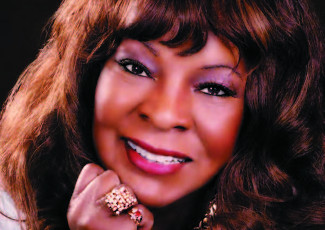
Martha Rose Reeves was born in Eufaula, Alabama on July 18, 1941. At a very young age, Reeves and her family moved to Detroit, Michigan, where her grandfather, Reverend Elijah Reeves, was a minister at Detroit’s Metropolitan
Church.
In 1959, after graduating from high school, she joined a girl group called the Fascinations and a year later joined the Del-Phis. The Del-Phis (Martha Reeves, Annette Beard, and Rosalind Ashford) later became Martha and the Vandellas. Throughout the 1960s, Martha and the Vandellas scored hit after hit with songs such as “Heat Wave,” “Quicksand,” “Nowhere To Run,” and “Dancing In The Street,” one of the biggest Motown singles ever released.
In 1995, Reeves was inducted into the Rock and Roll Hall of Fame. She is also a member of the Alabama Music Hall of Fame. In 2005, Reeves turned her sights toward politics and won a seat on the Detroit City Council.
In 1962, Motown’s Artist and Repertoire (A&R) Director, William “Mickey” Stevenson, heard the voice that would become synonymous with “the sound of young America.” A young jazz/blues singer with the unlikely name of “Martha Lavaille” was bringing audiences to their feet at Detroit’s famed 20 Grand Nightclub, singing songs made popular by singers like Gloria Lynne and Della Reese. Stevenson invited her to audition at the new Motown Records headquarters, nicknamed “Hitsville, USA.”
Though the audition never happened, within a year, Reeves was working with Stevenson at Motown Records in the company’s A&R department. She was responsible for ensuring musicians showed up on time and got paid. She watched, learned, and whenever the opportunity presented itself, she sang. And when she did, everyone took notice. When Mary Wells couldn’t make a session, Reeves was called to the mic. With her group, the Del-Phis, she recorded “I’ll Have to Let Him Go,” and the rest is history.
Martha and the Vandellas backed Marvin Gaye on his first three releases and sang with him on stage. Soon, they emerged from the shadows with “Come and Get These Memories,” followed by an enviable string of hits: “Heat Wave,” “Quicksand,” “In My Lonely Room,” “Nowhere To Run,” “My Baby Loves Me,” “Love Makes Me Do Foolish Things,” “I’m Ready For Love,” “Jimmy Mack,” and, of course, the Motown anthem, “Dancing In The Street.”
In 1972, Reeves left Motown Records seeking new artistic and musical horizons. She expanded her musical repertoire to include a myriad of styles such as rock, jazz, country, gospel, blues, and classical and performed with numerous artists including James Brown, Bruce Springsteen, opera diva Beverly Sills and gospel singer Bishop Rance Allen. Reeves headlined a national touring company of the musical “Ain’t Misbehaving,” and for three years toured the UK in the musical revue “Dancing In The Street.”
In 2004, Reeves produced her “Home to You” CD. It was named one of the year’s best by the Asbury Park Press. In 2005, Will Smith was searching the Motown vaults and discovered “It’s Easy To Fall In Love,” an unreleased gem by Reeves, and included it in the hit movie “Hitch.” Also in 2005, Motown released Reeves’ “Lost and Found” collection, which included the rare Smokey Robinson-penned “Spellbound,” her studio recording of “For Once In My Life,” and covers of hits by the likes of Aretha Franklin, the Marvelettes, Vikki Carr, Sam & Dave, and the Four Tops. Reeves was featured in the PBS special, “Motown: The Early Years.” Today, Reeves continues to thrill audiences around the world.
Resources
-
Miss Martha Reeves https://marthareeves.net/
-
Martha Reeves. (2015). The Biography.com website. Retrieved 11:06, May 27, 2015, from http://www.biography.com/people/martha-reeves-21169093.


